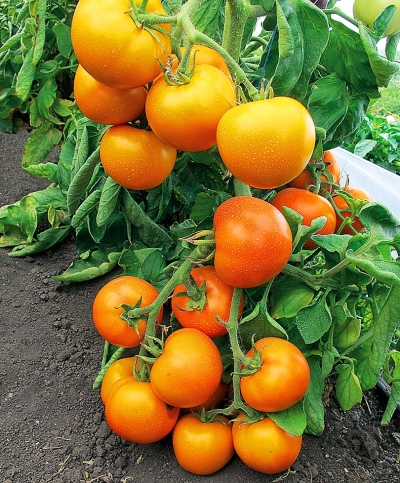
- Authors: Myazina L.A.
- Year of approval: 2008
- Category: hybrid
- Growth type: determinant
- Appointment: universal
- Ripening period: early
- Ripening time, days: 85-90
- Growing conditions: for open ground, for film greenhouses
- Bush size: undersized
- Bush height, cm: 90-100
The Golden Mother-in-law tomato fell in love with gardeners for its original orange color both inside the fruit and outside. But this is not the only thing that attracts farmers.
Breeding history
The F1 Golden Mother-in-law is a first-generation hybrid. The culture was brought up by the famous agronomist Lyubov Anatolyevna Myazina, a major specialist in tomato breeding. She has more than 25 varieties, as well as 4 dozen tomato hybrids. Many of them are early maturing, successfully cultivated in various farms. Golden mother-in-law is one of them, this is an early ripe hybrid, which was included in the State Register and received approval for use in different regions of the Russian Federation in 2008.
Description of the variety
The culture is stunted. The determinant bush grows in the range from 90 cm to 1 m. The leafiness is weak. Leaves are medium in size, green. The brushes ripen quite amicably. The inflorescence is simple, the stalk is articulated.
The main qualities of the fruit
The weight of one fruit of the Golden Mother-in-law is 100–120 g. The shape of the tomatoes is flat-round, ribbed. Tomatoes have a tough skin, which is why even ripe berries are different. The color of the tomato, which is just starting to ripen, is light green, while the ripe tomato has a bright orange color.
Taste characteristics
Golden mother-in-law - tomatoes are sweet, aromatic, rather juicy. The pulp is medium-dense, quite fleshy, and has an orange color, like the skin.
Ripening and fruiting
The culture belongs to the early, already 85-90 days after the first shoots, you can feast on delicious tomatoes.
Yield
These are high-yielding tomatoes. On open beds, you can get from 10 kg per sq. m and 4.5 kg per plant, while in greenhouses - as much as 6 kg per plant.
The timing of planting seedlings and planting in the ground
The seeds of this crop can be sown for seedlings in the second half of March. The sprouts of the Golden Mother-in-law are planted in the ground at the end of May, but only when there is no longer a chance of frost return.

Growing tomato seedlings is an extremely important process, because it largely depends on whether the gardener can harvest at all. All aspects must be taken into account, from seedbed preparation to planting in the ground.
Landing scheme
Seedlings are planted in a permanent place according to the scheme 60X70 cm.

Growing and caring
Hybrid nightshade culture Golden mother-in-law has a lot of advantages, but the main thing is good plant health and stable yield. As for agricultural technology, it does not particularly differ for the cultivation of this variety of tomatoes from the traditional cultivation of tomatoes. Nevertheless, there are a number of nuances, like any other culture, but they are all easy to perform even for beginners. To grow a good harvest of Golden Mother-in-law tomatoes, you need to follow simple rules.
- Hybrids usually prefer good fertile soil. At the same time, it is better if it is fertilized with organic matter.The acidity level should be no more than 6-7 pH - the culture loves either slightly acidic or neutral soil.
- Areas for planting grown seedlings of the Golden Mother-in-law should be chosen those that will be closed from gusts of wind, as well as from the scorching sun's rays.
- It is necessary to take into account the peculiarities of crop rotation. You should not organize the planting of tomatoes where nightshades, especially tomatoes, were previously grown.
- Before planting seedlings, the soil must be dug up, debris and weeds must be removed. In regions where the climate is cool, the crop can be grown using warm, tall beds.




A plant needs different micronutrients at each stage of growth. All fertilizers can be divided into two groups: mineral and organic. Folk remedies are often used: iodine, yeast, bird droppings, eggshells.
It is important to observe the rate and period of feeding. This also applies to folk remedies and organic fertilizers.
Disease and pest resistance
The culture is resistant to various negative weather and climatic conditions. The hybrid is drought-resistant, can set fruit perfectly even under unfavorable growing conditions.


Growing regions
It is possible to grow a Golden Mother-in-law tomato in various regions of the country, such as Central, North, North-West, Volgo-Vyatka, TsChO. And also in the North Caucasus, the middle and lower Volga, in the Urals, the Far East, in Western and Eastern Siberia.

























































































